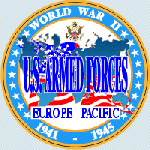 |  | 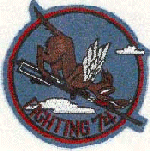 |
 |
 |
FRANCE REMEMBERS!
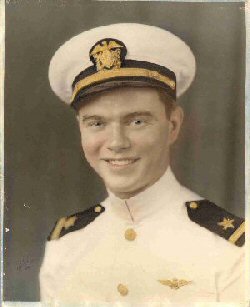
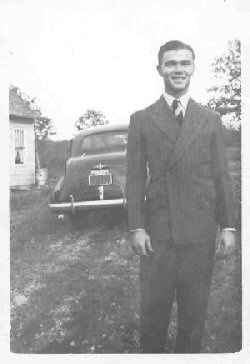
Charles Wilburn Scott Hulland was born October 1918 in St. Louis, MO to Charles William and Effie Gertrude (Roberts) Hulland. The census shows he had two sisters, Florence, born 1914 and Margaret born 1924. The 1920 US Census shows the family living on Gibson Ave., Independence City, St. Louis County, MO. Charles William was 26 years old and worked for an oil company, Gertrude was 24, Florence was 6 yrs old and young Charles was 14 months. By the 1930 census, the family had moved to Wichita Falls Texas, and a new daughter, Margaret was with them, age 6. Charles William was still working for an oil company as manager and taxman.
By 1944, the family had moved to Centralia, IL, and were still living there when Charles William died in October 1974, and Gertrude later.
On June 5, 1942, Charles W. S. Hulland enlisted in the US Naval Reserve. He then received an appointment to the Naval Air Training Center, Corpus Christi, TX on September 3, 1943. Ensign Hulland undertook pilot training at Melbourne, FL and Norfolk, then was assigned carrier duty in November 1943.

Fifty-eight years ago, August 15, 1944, the Allied invasion of Southern France, Operation Anvil - Dragoon, began. Hellcats, Wildcats, Spitfires, American and British aircraft carriers and destroyers struck at the German coastal defenses around the city of Me'ze in southwestern France, and the islands of the Mediterranean. The days would be hard fought as the Allies fight to gain a foothold in France, and many would die
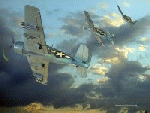
Flying cover for the infantry, the skies were filled with Allied planes. Their missions were to attack the gun emplacements, road convoys and munitions trains hurrying German troops to intercept the Allied invasion. Destroyers, USS Augusta, Quincy and Nevada pounded the coastal defenses constantly, guided by the Hellcats above. Bombers of the 12th and 15th Army Air Corps dropped their loads on designated targets, to further protect the troops.
At 06:02 AM, August 20, 1944, VF-74 Squadron, Flight #30, lifted off from the deck of the USS Kasaan Bay, heading inland toward Montpelier. The flight included Flight Leader, Lt. John H. Shroff, Lt. Gerald g. Hogan, Lt. William Nathan Arbuckle, Lt. John M Thomas, Ensign Thomas F Kendrick and Ensign Charles W. S. Hulland.
Outside Montpelier, the flight saw four wagons, which turned out to be munitions, on the roadside. They made one low level strafing run, resulting with one wagon exploding, sending debris 250’ into the air. This debris struck one of the 6 planes, knocking off sections of starboard elevator and stabilizer. The plane handled satisfactorily, the pilot apparently unaware of the seriousness of the damage, the flight continued on toward Balaruc.

On this heading, the flight located an enemy convoy of troop carriers, cargo and tank trucks. Due to poor weather in the area, the flight let down through the clouds, (ceiling approximately 600’) to strafe. The flight made four runs, in the face of light and medium Anti-Aircraft fire. Before relinquishing their attack, the pilots counted 15 troop carriers, 4 tank trucks and a command car on fire. The troop carriers were carrying enemy troops, many of whom were probably killed.
After these runs, the pilot of the aircraft damaged earlier by the exploding ammo wagon, Esign Kendrick, asked Flight leader, Lt. John H. Shroff to check the damage. At this point, Lt. JG. W. N. Arbuckle, USN, one of two pilots lost on the flight, was still flying right wing of the Flight Leader. Lt. Shroff circled the damaged plane, then ordered Ensign Kendrick to return to base, assigning another plane that had been damaged, Lt. Gerald Hogan as escort. They returned safely to the Kasaan Bay.
.
Immediately after these planes turned for base, Lt. Shroff looked for Arbuckle, but could not find him. Arbuckle was called on all radio frequencies, but did not respond. Lt. Shroff, Lt. Gerald G. Hogan, Ensign Charles Hulland and Lt. John M. Thomas circled the area for 10 minutes searching for him, and then continued with the mission. Lt. Arbuckle was never seen again. Unknown to them, his plane had been hit with AA fire and had crashed
They went to Beziers, followed the railroad west a short distance and then because of low visibility in the mountain region ahead, dropped south and swung around to Carcassonne, then up the railroad line to Villefranche de l'Auragais.
Just NW of this village a convoy of 25-30 trucks were sighted. The pilots attacked immediately, and met intense small arms fire. They strafed repeatedly, however, and left two tank trucks and two other trucks burning and an estimated 8 to 10 more destroyed.
After the planes had continued NW toward Toulouse, black smoke began streaming from the engine of Ensign Hulland's plane. He called the flight leader to report that his oil pressure was dropping to zero. Whether Hulland's plane was hit near Balaruc or near Villefranche is not known. The flight leader immediately made a 180 turn and led the formation on a heading of SSE in an effort to clear enemy territory as quickly as possible. A few minutes later Hulland radioed that his engine was turning up 3500 rpm and he didn't think the plane could make it.
Hulland bailed out near the village of St. Julien, about 13 miles south of Castelnaudary at 1600'. His parachute opened at 800' and he was seen to land safely and pull in his chute. The remaining pilots circled the area long enough to be certain Hulland was safe, then left to avoid disclosing his position to the enemy. Hulland's plane landed 100 yards from him, exploding and burning on impact. Flight leader and pilots returned to base.
Traveling by foot and various types of vehicles, Ensign Hulland made his way to London by September 9. He then went to Belfast, Newfoundland and back to New York then to Quonset Point RI by September 14, 1944. In December he was appointed Lt. jg and January, 1945, sent to the Pacific.

Lt. jg Charles Wilburn Scott Hulland was attached to the USS Shangri-La in the south Pacific. On April 23, 1945, flight Charlie was launched to fly combat air patrol in the Philippine Sea. The flight was a four plane division of two sections. Lt. John h. Shroff division leader and Lt. Noel R. Fox composed the first section; Lt. Charles Hulland and Ensign Myers, wingman, composed section two. The division was vectored out at 070 degrees from base to identify a target at 12 o'clock, seven miles, seven hundred feet. The division was then west of base.
Lt. Shroff, division leader, detached Lt. Hulland and Ensign Myers to fly below the clouds while Lt. Shroff and Lt. fox stayed above 3000 feet. The ceiling was about 1000 feet. Ensign Myers talley hoed a bogie at 12 o'clock, 700 feet. Both sections closed on the plane and identified it to be a C-34 flying at 800 - 100 feet heading 150 degrees. When Ensign Myers joined up 45 seconds later, Lt. Hulland was missing. Lt. Shroff and two remaining planes orbited the position then retraced their course.
The cause of the accident is not known. Lt. Charles Wilburn Scott Hulland was declared Missing in the line of duty and not as a result of his own misconduct. Routed to Lt. Cmdr Wright and after a full review of all the evidence in this matter was made, it was determined that the above named officer be continued in the status of "Missing." Neither his body nor the plane was found.

Lt. jg Charles Wilburn Scott Hulland is listed on the Tablets of the Missing at Manila American Cemetery Manila, Philippines.
Medals awarded Lt. Charles Wilburn Scott Hulland include: Navy Cross, American Campaign Medal, European African Middle Eastern Campaign Medal, Asiatic-Pacific Campaign Medal, Victory Medal WWII, Two United States Presidential Citations (France and Pacific, Croix de Guerre avec Palme, French Medal >
On October 6, 1996, Ensign Charles W. S. Hulland was honored with his name on a monument at les Villettes, France.
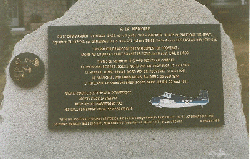
The information for this Memorial for USN Lt. Charles Wilburn Scott Hulland has been supplied by the researcher in France, Mr. Marcel Ertel. Thank you for making this possible. Thank you, Lt. Hulland, and all our military men and women, for your sacrifice for Freedom.
"People sleep peaceably at night because rough men stand ready to do violence on their behalf"......George Orwell
Protect them as they protect us. Bless them
and their families for the selfless acts they
perform for us in our time of need. I ask this
in the name of Jesus, our Lord and Savior.
Amen."
Web Page January 15, 2003